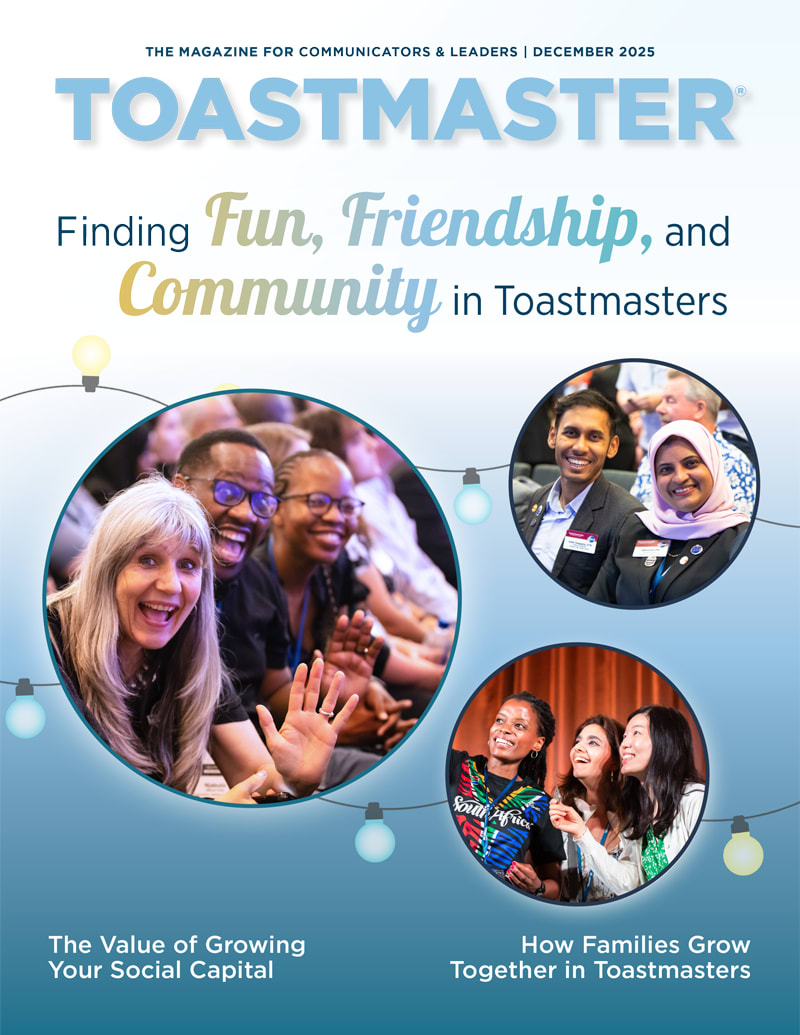




There comes a time in almost every Toastmaster’s journey when the road gets a little rocky or even a little too smooth, and you have to decide if you want to continue. Meetings can feel dull and routine, projects seem more like chores, officers get demanding.
It happens. But it doesn’t have to mean the end of your Toastmasters career. You can rekindle your interest and re-engage—not just for your own sake but for the good of your club as well. Each member supplies part of the energy that creates a meaningful experience for everyone. The longer you continue to go through the motions, the longer you’ll have to put up with a less engaging club experience.
Once you realize your interest has waned, the first step in re-energizing is to examine what might be happening to lower your enthusiasm. The reasons usually fall into one of three buckets: personal matters, club dynamics, or burnout. Here’s how some Toastmasters shook things up to reignite their passion.
Personal Matters
Life gets busy. Work and family obligations always take precedence, and you don’t have time to give Toastmasters the attention you’d like.
It’s okay to walk away. You can always come back when things calm down. According to a study from the World Headquarters Research and Analysis Department, 13% of members leave, but ultimately return later.
However, to try to maintain involvement, some members pay their dues but attend meetings occasionally, or they attend but don’t take a speaking role or a more involved meeting role.
Mike Diggins, a three-time Distinguished Toastmaster, has been a member since 1998 and is active in four clubs, including the Maungakiekie Club in Auckland, New Zealand. He lives by the motto “Give it a go.” Whether asked to take on an officer role or lead a special project, he usually jumps in with a “Let’s give it a go.”
Why not give it a go and try attending fewer meetings or only take a role on occasion? Be sure everyone understands this is your plan, and if someone ignores your wishes and asks you to do more, don’t be afraid to say no. Sometimes maintaining some involvement is more pleasant than feeling obligated to always attend when too much is going on at home. You never know what might happen in your club.
Diggins looks at it this way: “If I left today, who’s going to walk in the door tomorrow? If that person walks in and I’m not there to at least try and help, what was the whole point of having membership in the first place?”
Club Dynamics
Membership is dwindling and club officers have to scramble to put an agenda together. Or they lack imagination and are churning out the same meeting week after week.
For Danielle Barrett, DTM, of The Battlefords Club in North Battleford, Saskatchewan, Canada, the thrill began fading when membership fell during the COVID pandemic. Only seven or eight people regularly attended meetings. Then, in September 2023, the club lost three pivotal members with more than a century of combined Toastmasters experience.
Two retired their memberships after a combined total of 84 years. The third, a beloved officer active for over 25 years, passed away from terminal cancer. By the end of the 2023–2024 program year, the club had as few as three members consistently participating in club meetings.
“I thought, Why am I doing this? Why do I want to continue to give two hours of my week to this?” recalls Barrett, who joined the club in 2014. “You get [to the meeting] and you see that there are three people there and you immediately feel demotivated.”
She and the remaining members refused to give up. “I can’t speak for the others,” she says, “but for me it was, quite truly, guilt. Our recently deceased member would roll in her grave if we let the club fail, and I didn’t want to be part of the group that couldn’t find a way to succeed.”
Instead, they made several practical changes to their meeting format. They eliminated some roles so members wouldn’t have to take multiple roles. Some weeks, they didn’t have prepared speeches but extended Table Topics®, watched Pathways tutorials, or studied videos of the World Championships of Public Speaking.
Meanwhile, Barrett decided to visit a different online club every day. While still attending her in-person club’s meetings, she virtually visited clubs in every Toastmasters region and every province in Canada. Setting a goal to visit at least 55 clubs, Barrett visited 76 between early October and late December 2024. She learned new ways to make meetings fun and was inspired to host an open house to attract new members and perspectives.
Battlefords had an open house in January 2025 and enrolled eight new members. As of April 2025, it had 17 members and had achieved Distinguished status for the first time since 2020.
“We have a lot of youthful enthusiasm now at our meetings,” Barrett says. “We have new people to teach and learn from, and everybody’s just right back to being enthusiastic and passionate.”
Burnout
You’ve accomplished your initial goal of gaining confidence, improving public speaking skills, or finding your voice at work. It feels like there’s nothing left for you to achieve.
Diggins, the New Zealand Toastmaster, began to feel burnout when a company requested a Speechcraft program for 40 employees. Originally planning a single program for about 10 participants, Maungakiekie Club members conducted four—all at once. Diggins was disappointed in the program he and his overburdened team delivered.
“I was going to go off and lick my wounds, but then I thought, well, we gave it a go,” he says.
Instead, Diggins pushed through his disappointment and realized that he still gained valuable experience from the program. It’s all about changing your perspective and finding the opportunity in the challenge.
Another way to help shift your perspective is by finding a mentor who can help you set new goals. Or help another member achieve their goals by becoming a mentor yourself. Shifting the way you approach your role as a club member can help banish burnout.
Of course, taking a break or creating space for more fun is also an option when battling burnout.

Keep It Fun
If any members of Bishopstown Toastmasters feel unmotivated, it’s probably not for lack of trying by the club. Leaders make sure to keep meetings and events fun and engaging.
“We like to mix up the meetings from time to time,” says Conor Donovan, a member of the club in Cork, Ireland. They have a special meeting in December with holiday-themed poems and music. They also have joint meetings with neighboring Powdermills Club to strengthen bonds, and they keep things fresh by occasionally meeting in different venues. In September 2024, they met at the local university and received a guided tour before the meeting.
“These activities foster a strong sense of community,” Donovan says. “This really helps to retain engagement and enthusiasm.”
Shaking things up can benefit all members and renew your enthusiasm. Invite a new friend to a meeting, volunteer for a more creative role, or pick a fun meeting theme next time you serve as Toastmaster of the Day. Get creative to re-engage, whether you’re managing challenges at home, feeling discouraged by the monotony of your regular meetings, or simply running out of steam.
When faced with low enthusiasm or lack of motivation, Diggins likes to quote Helen Blanchard, DTM, the first woman to serve as Toastmasters International President: “If you get out of Toastmasters all that there is to get out of Toastmasters, you’ll never get out of Toastmasters.”
Kate McClare, DTM , is a professional writer and editor who joined Toastmasters in 2011. She is a member of Miami Advanced Toastmasters Club in Kendall, Florida, and an Area Director for District 47, Southeast Florida and The Bahamas.
Related Articles

Personal Growth
Finding a Balance to Beat Burnout

Club Experience
Break Away From the Everyday

Club Experience



 Previous
Previous

 Previous Article
Previous Article